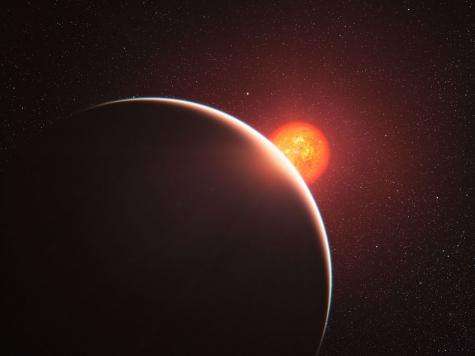Exoplanet may have metal-rich atmosphere

At first glance, GJ 1214b is just another of the growing number of the super-Earth class of exoplanets. Discovered by the MEarth Project in 2009, it orbits an M dwarf in Ophiuchus in a tight orbit, swinging the planet around every 1.6 days. Late last year, GJ 1214b became the first super-Earth to have a component of its atmosphere detected when astronomers compared its spectra to models finding broad agreement with water vapor present. New work, done by the same team, further refines the atmosphere’s potential characteristics.
Previously, the team suggested that their observations could potentially fit with two hypothetical planet models. In the first, the planet could be covered in hydrogen and helium, but the lack of absorption features in the atmosphere’s spectra suggested that this were not the case unless this layer were hidden by thick clouds. However, from the data available, they could not conclusively rule out this possibility.
Combining their old observations with more recent ones from the MEarth Observatory, the team now reports that they have been able to rule out this scenario with a 4.5 σ confidence (over 99.99%). The result of this is that the remaining model, which contains higher amounts of "metals" (astronomy speak meaning all elements with atomic numbers higher than helium). The team also continues to support their earlier conclusion that the atmosphere is most likely at least 10% water vapor by volume, stating this with a 3 σ (or 99.7%) confidence based on the new observations. While water vapor may sound give the impression of being an inviting place for a tropical jungle, the team predicts the close orbiting planet would be a sweltering 535 degrees Fahrenheit.
While these findings are interesting stories of the atmosphere, the prevalence of such heavy elements may also give information relating to the structure and history of the planet itself. Models of planetary atmosphere suggest that, for planets of the mass and temperature expected for GJ 1214b, there are two primary formation scenarios. In the first, the atmosphere is directly accreted during the planet’s formation. However, this would indicate a hydrogen rich atmosphere and has been ruled out. The second is that the planet formed further out, beyond the “snow line”, as an icy body, but moved in after formation, creating the atmosphere from sublimated ices.
Although outside of the scope of their atmospheric research, the team also used the timing of the transits to search for wobbles in the orbit that could be caused by additional planets in the system. Ultimately, none were discovered.
Source: Universe Today




















